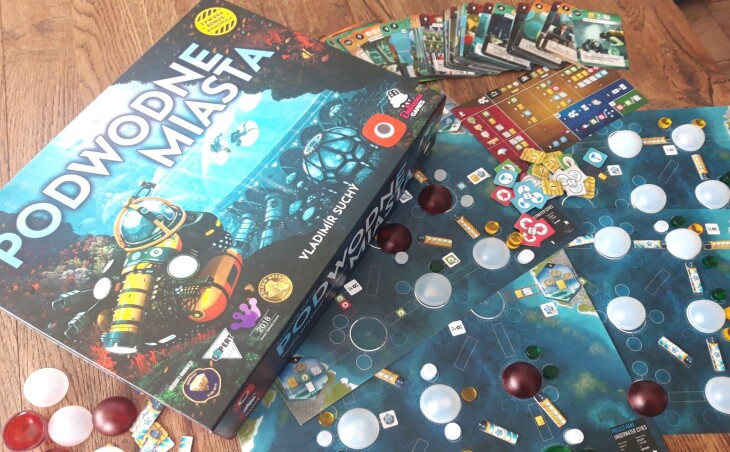Vladimír Suchý, like no other board game author, is associated primarily with the so-called eurosuchars. Underwater cities are also included in this group, although I am not looking for atmosphere here, but interesting, neatly combined mechanics…
Instead of going into space, let’s delve into the ocean
I would like to emphasize that I do not intend to explain all the rules, because there are too many of them, so I will only briefly present the most important elements contained in Underwater Cities . First of all, the worker placement mechanism is combined with playing cards. Interestingly, you have to pay attention to the color, because if the color on the card is different than on the field, then we only perform a board effect and the card is discarded. Thanks to these two mechanisms, we can build domes or buildings producing credits/algae/plasterel/science tokens on our underwater board. It is also crucial to create tunnels connecting our underwater cities with metropolises located on the surface. After three or four rounds, the production phase begins. This is when we gain a lot of resources thanks to the buildings we have built and the cards we have played. The winner is the person who collects more victory points, which are obtained by building domes, playing special cards, and by selling remaining resources.
The more domes the better
I heard a lot of good things about Underwater Cities , but I wasn’t interested in this title. And it turns out that it was a serious mistake, because Vladimír Suchy’s board game is a great Euro game. We need to optimize our moves well to obtain the benefits we need from the fields on the board and at the same time connect it to the card. And what I liked most was the synergy between playing cards and the worker placement mechanics. It works really great. Although, of course, we know that fate has some influence on our plans and sometimes it happens that we do not choose a card of the right suit.
I also like the expansion of the domes. On the one hand, we try to optimize production by building buildings of the same color, but at the end of the game we will get more points for a city surrounded by different buildings. However, the best thing is that even with few raw materials, we can still do quite a lot. Just play around a bit and you can create quite a nice combo. If I had to complain about anything other than the randomness, it would probably be the card effects, which are not very spectacular. Some of it is also very situational. Moreover, the basis is immediate effects, not permanent bonuses. But that’s the charm of Underwater Cities .
The beauty of the underwater world
The edition is certainly solid and readable. However, it’s a pity that there are no bigger fireworks here. The domes look nice on the board, and the remaining buildings are just simple round markers in different colors. The cards are also not impressive, and it’s not about the graphic style, but the repetition of illustrations and even card names. It was a good move on the part of the publisher to add a help sheet to the game for each player. It’s a pity that it wasn’t designed a little better, but after the first game it’s easier to get the hang of it, and there’s no denying that it’s an invaluable support in the game. Additionally, the player boards could be a bit thicker.
In the end, these are just minor details, because overall everything works well in a game that is exceptionally easy to disassemble and assemble on the table. Although the game itself can easily last up to three hours with a full team. However, solo play is exceptionally smooth and very enjoyable. It’s true that we only try to build seven cities and get at least a hundred victory points, but the mechanics in this game are so enjoyable that when I have a free hour, I’m always willing to play.
Is it worth becoming an undersea architect?
Underwater cities stand out from the crowd of other Euro games not because of their unconventional mechanisms, but rather because of a neat combination of interesting mechanics. On the one hand, you have to do a lot of work to win this game, but on the other hand, there is not such a long downtime. All because we have a limit of three cards in our hand and we usually try to choose fields in the color of the card we have in our hand. And this limitation can hurt, mainly due to randomness, and on the other hand, it affects the smoothness of the game. Thanks to Underwater Cities , I already know that I should pay close attention to the work of Vladimír Suchy, because his work creates really solid, interesting Eurasians.
Nasza ocena: 7.5/10
Underwater Cities is a solid Euro game that neatly combines worker placement mechanics with card playing.REPLAYABILITY: 7/10
PRODUCTION QUALITY: 7/10
PLAYABILITY: 8.5/10

